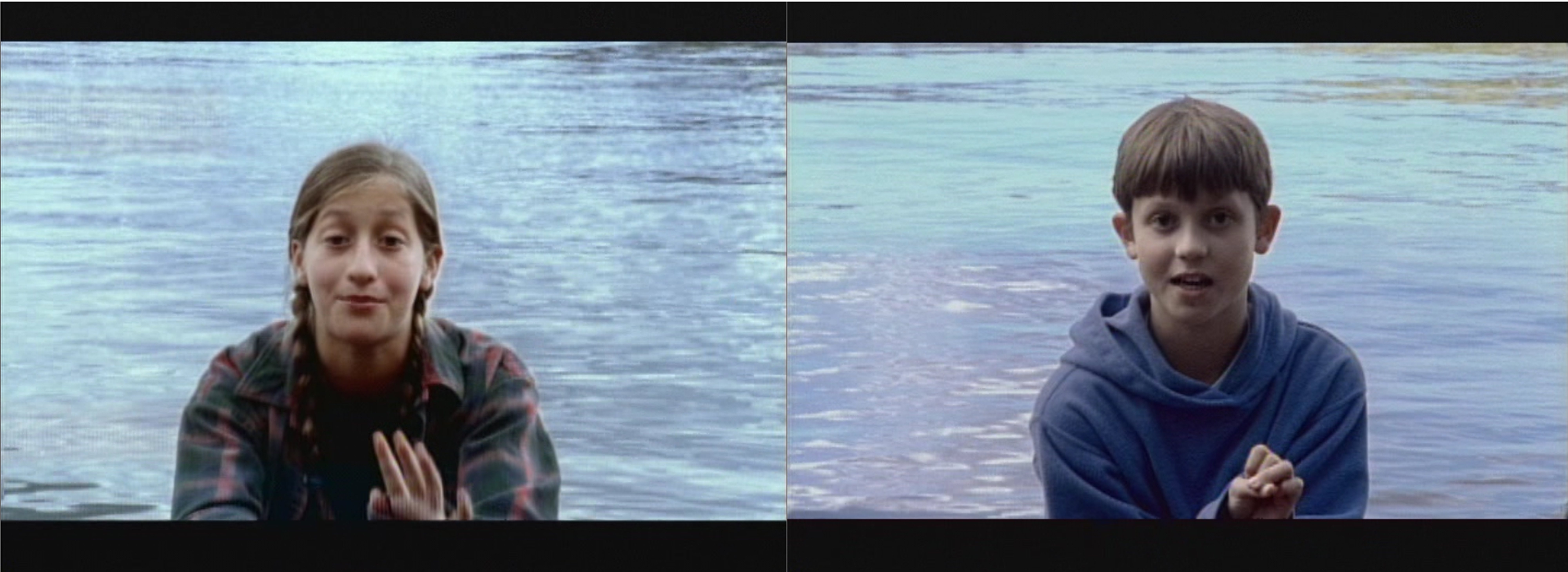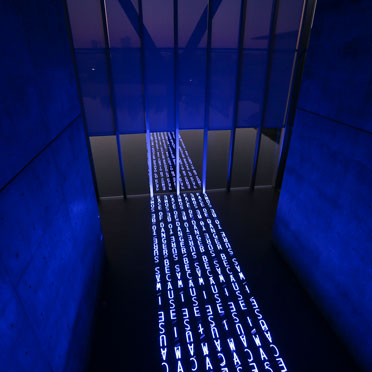Pretty Baby

Anna Gaskell
That's All I Remember (Still), 2006
16MM film, 2:52
Courtesy Yvon Lambert New York/Paris
Pretty Baby, organized by Curator Andrea Karnes and the Modern Art Museum of Fort Worth, explores various notions of childhood identity in contemporary art. International in scope, the exhibition features approximately sixty works by thirteen artists in various media, including painting, photography, sound, installation, and video. From images of innocent childlike reverie to works that question established idealized states of childhood, the exhibition comprises pieces by Sanford Biggers, Jennifer Zackin, Rineke Dijkstra, Nathalie Djurberg, Adam Fuss, Anna Gaskell, Miranda July, Makiko Kudo, Loretta Lux, Margaret Meehan, Yoshitomo Nara, Catherine Opie, and Charlotta Westergren.
For centuries, the image of the child has been a symbol for innocence. Since the Victorian era, the idea of the innocent child has been reinforced collectively not only in paintings, prints, and photography, but also in literary works such as Lewis Carroll's Alice's Adventures in Wonderland. But what was thought by some simply to depict childhood innocence might just as easily be seen as repressed symbolism relating to sexuality and death. However hidden or overt this symbolism was to the Victorians, our own recent history makes it difficult, if not impossible, to overlook the wide-ranging connotations provoked by images of children.
In the last several decades, portrayals of childhood have incited intense reactions, from euphoria to revulsion to extreme fear. In fact, the image of the child in commercial advertising, film, and fine art has become a central barometer for changing societal values and mores. This is exemplified in a provocative and popular television commercial for Calvin Klein jeans that aired in the late 1970s and early 1980s featuring the child actress and model Brooke Shields. In the advertisement, the thirteen-year-old Shields, wearing tight jeans and lying on her back with her legs reaching upward, suggestively asks, "You know what comes between me and my Calvins? Nothing." The ad sparked a range of interpretations, from youth empowerment to obscenity. Nevertheless, Calvin Klein, capitalizing on the controversy surrounding Louis Malle's 1978 film Pretty Baby, which starred the pubescent Shields and addressed the taboo subject of child prostitution, created one of the most controversial—and successful—ads in Madison Avenue history.
In the 1990s, the artist Sally Mann was met with a different type of criticism because the children in her images were her own. Mann began photographing her three children in 1984 for what would be published in 1992 as a monograph entitled Immediate Family. The first picture in the series, Damaged Child, shows a close-up view of the artist's young daughter Jessie, then two years old. In the image, the child's left eye is inflamed, suggesting a range of interpretations, from child abuse to what was strictly depicted: the child's temporarily "damaged" face, swollen from insect bites. Like Damaged Child, all of the formally beautiful pictures in Immediate Family present several possible readings. And undoubtedly, in showing her children naked, moody, and in suggestive situations, Mann evokes an edgy, dark side of childhood. At its debut, Immediate Family was met with a mix of praise and discussions of parental rights, exploitation, and childhood consent. Although Mann's work is not included in Pretty Baby, undoubtedly her images of children have been influential to the Western artists in the exhibition.
In postwar Japan, a different context created and defined the dialectic between innocence and loss of innocence, marked by the atomic bombings of Hiroshima and Nagasaki in 1945. Indeed, much of the imagery created in postwar Japan is centered on the image of the child and childhood. These portrayals, in their various forms, might be seen as visual manifestations of the process of recovery from the profound effects of atomic devastation. Often depicting fantastical childhood and adolescent motifs in isolated situations, Japanese artists create imagery that crosses the spectrum from innocence to eroticism, and is used to express a range of conditions, including empathy, bravery, vulnerability, loneliness, and fear.
The works in Pretty Baby represent a culmination of the many impulses related to childhood that have been historically represented by artists. The contemporary artists featured in this exhibition view children with a more inclusive eye. Curator Andrea Karnes explains, "Today's images of children seldom depict innocence without irony. Artists in this exhibition share a willingness to acknowledge the complex nature of the child, and in doing so, they overturn well-established constructs of childhood innocence."
Artist Highlights
Rineke Dijkstra
Rineke Dijkstra, born in 1959, lives and works in Amsterdam. For her Bathers series, she photographed adolescents in formal poses wearing their bathing suits. The images were made in various locations along coastlines in Central and Eastern Europe and America. In a broad sense, the portraits are emblematic of the particular societies from which they come, creating an intriguing comparison between, for example, the unadorned European girl in a modest bathing suit pictured in De Panne, Belgium, August 7, 1992 and the preppy, posturing American boys in Hilton Head Island, South Carolina, USA, June 24, 1992. Initially straightforward, upon closer examination the photographs reveal uncanny psychological aspects of the sitters, isolating a mix of pride and physical and emotional vulnerability. With the delicate timing of her beach portraits, Dijkstra shows an extraordinary stage of being human—acknowledging the anxiety and loneliness associated with the moment between childhood and adulthood. Regarding her photographic style, the artist has explained, "I discovered that if you want to give a general impression, you should be very specific."
Yoshitomo Nara
Yoshitomo Nara, born in 1959, lives and works in Japan. The Japanese Pop art movement of the mid-1990s marks Nara's emergence as one of the most influential artists in his country. Nara has based his career on deceptively simple images of defiant children and docile puppies. His artistic style—outlined forms with no shadows or modeling—and the large-eyed, generic figures he portrays owe directly to Japanese manga and anime, whose characters are typically cartoon-like, flat, and highly stylized. In this way his work is like that of many contemporary artists in Japan. Nara's portrayal of adorable children in various states of rebellion, however, is also heavily influenced by the punk music scene. The expressions of the children—sad, vulnerable, defensive, accusatory, irritable—combined with their cuteness suggest a perversion of childhood innocence. Isolated and still, often brandishing weapons, Nara's children also convey protectiveness and heroicism by appropriating adult aspirations. His imagery is timely, given Japan's rigid societal rules and controlled social structure and the country's recent history—well documented by the Tokyo press—of escalating violent crimes carried out by children.
Catherine Opie
Catherine Opie, born in 1961, lives and works in Los Angeles and New York City. Opie's Self-Portrait (2004) is a straightforward depiction of the artist nursing her young son, Oliver. However, the image is jarring in its juxtaposition and disclosure. On the one hand, the pose and subject matter initially conjure numerous references to the history of art, from pieta and Madonna and Child imagery to the nineteenth-century artist Berthe Morisot's well-known Impressionist painting Wet Nurse and Julie (1879). On the other hand, it shows a tattooed, burly woman cradling a baby as the two gaze into each others' eyes. Opie's portrait represents her continuing investigation into growing subcultures in contemporary American society.
Throughout her career, Opie has addressed the idea of community, creating series that range from portraits of surfers and children, for example, to landscapes of rural signage and more recently, the facades of Beverly Hills homes. She has also created portraits of the gay and lesbian community and transgendered individuals as part of her ongoing investigation into the fluidity of sexuality and gender, which for the artist touches on personal and public issues. In Self-Portrait, Opie adds a layer to the complexity of identity by representing the altered family. In the image, a scar reading "pervert" is still slightly legible on the artist's chest, the result of her cutting the word into her skin for an earlier self-portrait in which she acknowledged American societal prejudice against lesbianism. The combination of blunt honesty and tenderness depicted in the photograph can be seen in various ways in all of Opie’s images.
Anna Gaskell
That's All I Remember (Still), 2006
16MM film, 2:52
Courtesy Yvon Lambert New York/Paris
